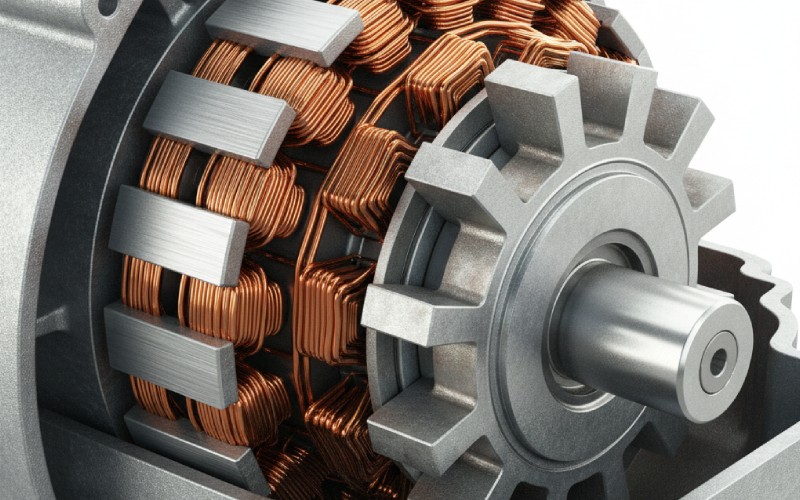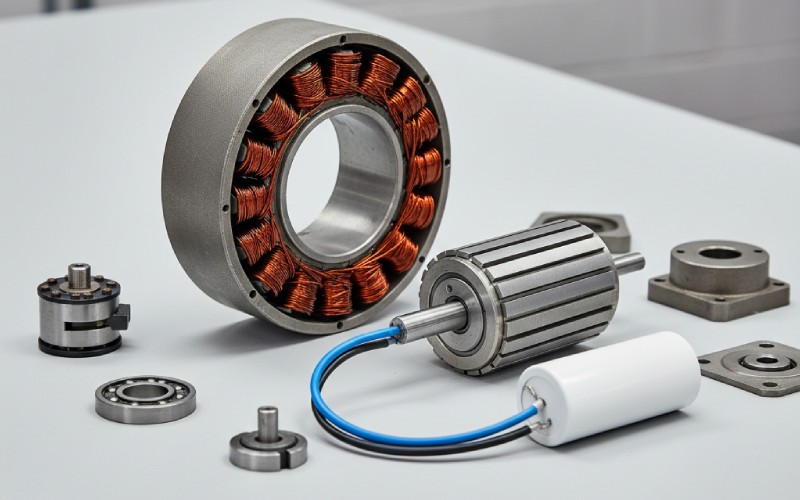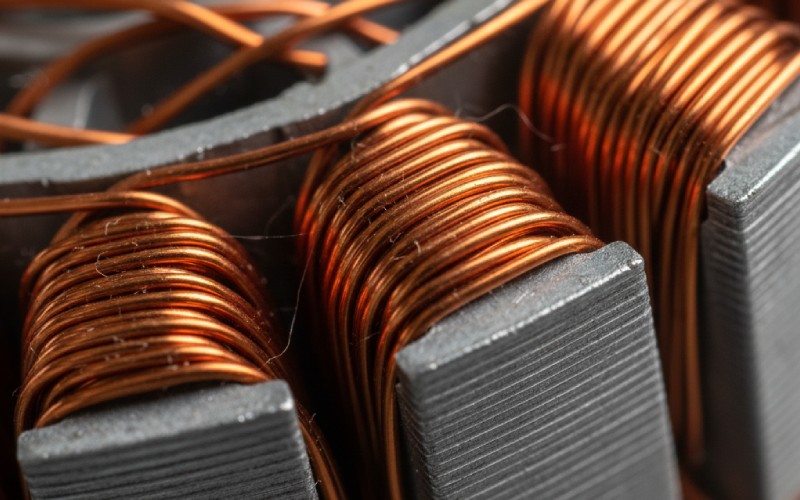Sino의 라미네이션 스택으로 프로젝트에 힘을 실어주세요!
프로젝트 속도를 높이기 위해 라미네이션 스택에 다음과 같은 세부 정보를 레이블로 지정할 수 있습니다. 허용 오차, 재료, 표면 마감, 산화 단열재가 필요한지 여부, 수량등 다양한 기능을 제공합니다.

선풍기나 세탁기가 돌아가는 원리에 대해 생각해 본 적이 있나요? 정답은 단상 AC 모터라는 작지만 강력한 엔진입니다. 이 글에서는 이 일반적인 모터가 어떻게 작동하는지 간단하게 설명합니다. 모터 내부를 들여다보며 부품을 살펴볼 것입니다. 이 모터가 시동되고 계속 작동하는 데 도움이되는 쉬운 비밀을 배우게됩니다. 매일 사용하는 기계를 새롭고 간단한 방법으로 이해할 수 있기 때문에 이 글을 읽어보시기 바랍니다.
단상 AC 모터는 전기 모터의 일종입니다. 단상 교류 또는 AC라고 하는 전력 유형을 사용합니다. 이것은 집의 벽면 콘센트에서 나오는 것과 같은 종류의 전력입니다. 이러한 AC 모터는 여러 곳에서 사용됩니다. 냉장고, 에어컨, 그리고 많은 소형 공구의 내부에 있습니다. 모든 모터의 주된 목적은 전력을 운동으로 바꾸는 것입니다. 이 단상 모터는 작은 작업에서 그 역할을 매우 잘 수행합니다.
이 모터의 기본 개념은 이해하기 쉽습니다. 모터는 크게 두 부분으로 구성됩니다. 첫 번째 부분은 고정자. 고정자는 모터에서 움직이지 않고 가만히 있는 부분입니다. 고정자에는 권선이라고 하는 원으로 감긴 와이어가 있습니다. 교류 전류가 이 권선을 통과하면 자기장을 만듭니다. 두 번째 부분은 로터. 로터는 모터에서 회전하는 부분입니다. 널리 사용되는 AC 모터 유형인 유도 모터에서 로터는 종종 "다람쥐 우리"처럼 보입니다. 이 로터도 전류에서 자기장을 받습니다. 그러면 두 자기장이 서로 밀고 당기게 됩니다. 이 작용으로 로터가 회전, 즉 회전합니다. 이 회전이 기기에 전력을 공급합니다. 이 모터 작동은 많은 기계에서 매우 중요합니다.
아주 단순한 단상 모터에는 큰 문제가 있습니다. 스스로 회전을 시작할 수 없습니다. 플러그를 꽂으면 윙윙거리는 소리만 나고 가만히 있을 뿐입니다. 이는 AC 전원이 자기장을 만들어 한 지점에서 앞뒤로 밀고 당기기 때문에 발생합니다. 그네를 밀고 있다고 생각하면 됩니다. 그네 바로 앞에 서서 그네를 앞으로 밀었다가 뒤로 당기면 그네는 실제로 아무 데도 가지 않습니다. 이 기본 모터의 자기장도 로터에 같은 작용을 합니다. 밀고 당기지만 로터가 회전하기 시작하지는 않습니다.
로터를 회전시키려면 모터에 앞뒤로 밀고 당기는 자기장이 아니라 회전하는 자기장이 필요합니다. 3상 모터는 문제없이 회전 자기장을 만들 수 있지만 단상 모터는 그렇지 못합니다. 이 모터의 단일 고정자 권선에 의해 만들어지는 자계는 점점 강해졌다가 약해집니다. 모터 주위를 움직이지 않습니다. 자기장이 회전하지 않기 때문에 회전자에 회전을 시작하는 데 필요한 첫 번째 힘을 줄 수 없습니다. 이러한 이유로 이런 종류의 모터는 시작하기 위해 약간의 도움이 필요합니다. 다양한 종류의 단상 모터는 모두 모터에 첫 번째 추진력을 제공하는 영리한 방법일 뿐입니다.
분할 위상 모터는 단상 유도 모터의 스마트한 일종입니다. 이 모터는 쉬운 방법으로 시동 문제를 해결합니다. 이 모터는 고정자에 권선이 하나가 아닌 두 개가 있습니다. 첫 번째는 메인 와인딩입니다. 두 번째는 추가 권선입니다. 보조 와인딩 또는 시동 와인딩. 이 보조 와인딩은 모터의 시동을 돕는 비밀입니다. 메인 와인딩과는 다르게 만들어졌습니다. 보조 권선은 루프 수가 적은 더 작은 와이어를 사용합니다. 따라서 저항이 더 높습니다.
모터를 켜면 전류가 양쪽 권선을 모두 통과합니다. 보조 권선은 서로 다르기 때문에 보조 권선을 통과하는 전류가 주 권선의 전류와 동기화되지 않습니다. 이 차이로 인해 자기장이 회전하지만 그다지 강하지는 않습니다. 완벽한 회전 자기장은 아니지만 로터가 회전을 시작하기에 충분할 정도로 강합니다. 그네를 앞쪽이 아닌 옆쪽에서 밀어주는 것과 같습니다. 이 첫 번째 추진력이 모터에 필요한 전부입니다.
모터가 최고 속도 약 75%에 도달하면 특수 스위치인 원심 스위치 이 열립니다. 이 스위치는 로터에 있습니다. 로터가 빠르게 회전하면 작은 추가 날아가 스위치가 열립니다. 그러면 보조 권선의 전원이 차단됩니다. 이 시점에서 모터는 주 권선만 사용하여 작동합니다. 모터는 로터의 회전으로 계속 작동하기 때문에 보조 권선이 더 이상 필요하지 않습니다. 이 분할 위상 모터 설계는 자체적으로 시동할 수 있는 모터를 저렴하게 제작할 수 있는 방법입니다.

단상 모터에는 몇 가지 종류가 있습니다. 각 모터 유형은 시동 방법과 설정이 다릅니다. 특정 작업에 적합한 모터는 해당 모터가 필요한 작업에 따라 달라집니다. 어떤 모터는 시작할 때 강하게 밀어주는 반면, 어떤 모터는 큰 소음 없이 전력 낭비 없이 작동하는 데 더 좋습니다. 이러한 다양한 종류의 모터에 대해 알면 작업에 적합한 모터를 선택하는 데 도움이 됩니다.
단상 모터의 주요 종류는 다음과 같습니다:
이 모터의 가장 큰 차이점은 두 번째 위상의 전류를 만드는 방식입니다. 이 두 번째 위상은 회전하는 자기장을 만드는 데 필요합니다. 분할 위상 모터는 보조 권선에 다른 종류의 와이어를 사용하여 이를 수행합니다. 커패시터 모터는 커패시터를 사용하여 전류가 더 많이 동기화되도록 합니다. 음영 극 모터는 극에 특수 구리 링을 사용합니다.
커패시터 기동 모터는 단순한 분할 위상 모터에서 크게 발전한 모터입니다. 이 모터는 커패시터 모터의 일종입니다. 분할 위상 모터와 마찬가지로 주 권선과 원심 스위치가 있는 보조 권선이 있습니다. 가장 큰 차이점은 커패시터 는 보조 권선과 일렬로 연결됩니다. 커패시터는 에너지를 저장했다가 방출할 수 있는 전기 부품입니다. 이 모터에서 커패시터는 보조 권선으로 흐르는 전류를 훨씬 더 동기화하지 못하게 합니다. 따라서 모터가 시동될 때 2상 모터처럼 작동합니다.
이렇게 전류의 차이가 크면 회전 자기장이 훨씬 더 강해집니다. 그 결과 훨씬 더 높은 시동 토크가 발생합니다. 시동 토크는 모터가 시동할 때 모터가 만들어낼 수 있는 비틀림 힘의 양입니다. 시동 토크가 높은 모터는 무거운 부하에 연결되어 있어도 시동을 걸 수 있습니다. 따라서 커패시터 기동 모터는 공기 압축기나 대형 펌프와 같이 움직이기 어려운 기계에 적합합니다.
모터가 최고 속도 약 75%에 도달하면 원심 스위치가 열립니다. 보조 권선과 커패시터가 모두 꺼집니다. 그러면 모터는 주 권선만 사용하여 작동합니다. 이 모터는 일단 작동하면 많은 에너지를 절약하는 방식으로 작동합니다. 커패시터는 처음에 짧은 시간 동안만 사용되므로 비용이 많이 들지 않는 작은 부품이 될 수 있습니다. 이 모터의 가장 큰 장점은 뛰어난 시동력입니다.
영구 분할 커패시터(PSC) 모터는 커패시터 모터의 또 다른 종류입니다. 이름만 들어도 특별한 점이 무엇인지 정확히 알 수 있습니다. 커패시터는 항상 회로에 연결되어 있습니다. 이 모터에는 보조 권선이나 커패시터를 끄는 원심 스위치가 없습니다. 모터가 켜져 있는 동안에는 주 권선과 커패시터가 있는 보조 권선이 모두 작동합니다.
커패시터는 항상 사용되기 때문에 다른 유형의 커패시터를 선택해야 합니다. 잠시 동안이 아니라 항상 작동하도록 만들어야 합니다. 이런 종류의 모터는 커패시터 시동 모터의 강력한 시동 푸시가 없습니다. 실제로 시동 푸시는 상당히 약합니다. 하지만 이 모터에는 다른 장점도 있습니다. 매우 조용하고 매우 부드럽게 작동합니다. 또한 분할 위상 모터보다 전력 낭비가 적습니다.
집의 난방 및 공기 시스템과 같은 선풍기와 송풍기에는 영구 분할 커패시터 모터가 장착되어 있는 경우가 많습니다. 이러한 작업에는 강력한 시동이 필요하지 않습니다. 조용하고 전력을 절약하는 모터가 더 중요합니다. 이 모터는 전압을 조절하여 속도를 쉽게 변경할 수 있습니다. 따라서 다양한 속도 레벨이 필요한 팬에게 좋은 선택입니다. 이 모터는 비용과 성능의 좋은 조합을 제공합니다.
예, 방금 이야기한 두 가지 커패시터 모터의 장점만을 모아 모터를 더 잘 작동시킬 수 있습니다. 이 모터를 커패시터 기동, 커패시터 구동 모터라고 합니다. 최고의 단상 모터이지만 가장 비용이 많이 드는 모터이기도 합니다. 이 모터는 두 개의 커패시터를 사용하여 시동 시와 최고 속도로 작동할 때 가장 잘 작동합니다.
이 모터 설정에는 두 개의 커패시터가 있습니다. 하나는 큰 값을 가진 시동 커패시터입니다. 커패시터 시동 모터와 마찬가지로 보조 권선과 일렬로 연결됩니다. 이것은 모터가 무거운 물건을 움직일 수 있도록 매우 강력한 시동력을 제공합니다. 더 작은 값의 런 커패시터인 두 번째 커패시터도 있습니다. 이 영구 커패시터는 모터가 작동하는 동안 보조 권선에 연결된 상태를 유지합니다.
작동 원리는 다음과 같습니다: 모터가 작동하기 시작하면 두 커패시터가 모두 회로에 들어갑니다. 이들은 한 팀으로 작동하여 매우 강한 회전 자기장과 매우 높은 시동 토크를 만들어냅니다. 모터의 속도가 빨라지면 원심 스위치가 시동 커패시터를 끕니다. 모터는 주 권선과 보조 권선으로 계속 작동하며, 보조 권선에는 여전히 런 커패시터가 있습니다. 이 설정은 모터를 매우 부드럽고 조용하게, 그리고 전력 낭비 없이 작동하게 합니다. 이 모터는 강력한 시동과 뛰어난 주행 성능 등 모든 면에서 최고의 성능을 제공합니다.
음영 극 모터는 가장 간단하고 비용이 가장 적게 드는 단상 모터입니다. 매우 간단한 방식으로 제작됩니다. 이 모터는 고정자에 극이 있고 각 극의 한 조각이 구리 링으로 감겨 있습니다. 이 링을 차광 코일이라고 합니다. 이것이 모터의 이름을 얻은 방법입니다. 음영 극 모터에는 보조 권선이나 커패시터가 없습니다. 매우 다른 종류의 모터입니다.
작동 원리는 다음과 같습니다. 교류 전류가 고정자 권선을 통과하면 자기장이 변화하기 시작합니다. 셰이딩 코일은 이 변화를 밀어냅니다. 이 작용으로 인해 극의 "음영" 부분의 자기장이 주 부분의 자기장보다 약간 뒤처지게 됩니다. 이 지연은 매우 약한 회전 자기장을 만듭니다. 자기장은 극의 음영이 없는 부분에서 음영이 있는 부분으로 이동하는 것처럼 보입니다. 이 정도면 로터가 회전하기 시작하기에 충분합니다.
회전장이 매우 약하기 때문에 이 모터는 시동 푸시력이 매우 약합니다. 시동하기 쉬운 작은 작업에만 사용할 수 있습니다. 음영 극 모터는 또한 많은 전력을 낭비합니다. 그러나 제작 비용이 매우 저렴하고 믿을 수 있으며 간단합니다. 이 모터는 소형 선풍기, 어항용 펌프 및 저렴한 가격이 가장 중요한 요소이고 모터의 저전력이 문제가 되지 않는 기타 작은 것들에서 볼 수 있습니다. 이것은 매우 인기 있는 소형 AC 모터입니다.

올바른 단상 모터를 선택하려면 모터가 어떻게 다른지 살펴봐야 합니다. 모터 유형에 따라 다른 용도에 적합합니다. 주로 살펴봐야 할 사항은 시동 푸시, 가격, 전력 절감량, 모터의 조용함입니다. 간단한 표를 통해 모터 설계의 차이점을 확인할 수 있습니다. 이 비교를 통해 대형 선풍기에는 왜 한 모터가 사용되고 소형 선풍기에는 다른 모터가 사용되는지 알 수 있습니다.
다음은 단상 모터의 주요 종류를 비교하는 데 도움이 되는 표입니다:
| 모터 유형 | 푸시 시작 | 가격 | 절전 | 공통 사용 |
|---|---|---|---|---|
| 분할 위상 모터 | 낮음 | 낮음 | Medium | 소형 공구, 선풍기, 송풍기 |
| 커패시터-시동 모터 | 높음 | Medium | 높음 | 컴프레서, 펌프, 대형 기계 |
| 영구 분할 커패시터 모터 | 낮음 | Medium | 높음 | 팬, 송풍기(HVAC 시스템) |
| 커패시터 시동, 커패시터 구동 모터 | 매우 높음 | 높음 | 매우 높음 | 목공 기계, 대형 장비 |
| 음영극 모터 | 매우 낮음 | 매우 낮음 | 낮음 | 소형 선풍기, 소형 펌프, 장난감 |
보시다시피, 모터를 선택하는 것은 하나를 포기하고 다른 것을 얻는 선택입니다. 힘든 작업을 위해 강력한 시동력을 갖춘 모터가 필요하다면 커패시터 모터에 더 많은 비용을 지불해야 합니다. 작고 저렴한 팬용 모터만 필요하다면 음영극 모터가 매우 좋은 선택입니다. 각 모터의 특별한 특성을 이해하는 것은 매우 중요합니다.
단상 모터를 선택하는 가장 좋은 방법은 전적으로 모터가 필요한 작업에 따라 달라집니다. 모터가 무엇을 해야 하는지 생각해야 합니다. 몇 가지 중요한 질문을 스스로에게 던져야 합니다. 첫째, 모터에 얼마나 많은 시동 푸시가 필요한가? 압축기의 피스톤처럼 모터가 무거운 것을 시동해야 하는 경우 높은 시동 토크가 필요합니다. 커패시터 시동 모터가 현명한 선택이 될 수 있습니다.
둘째, 모터에 얼마를 지출할 수 있나요? 가격은 종종 고려해야 할 중요한 사항입니다. 완벽하게 작동하는 것이 가장 중요하지 않은 간단한 기계의 경우, 분할 위상 또는 음극 모터와 같은 저비용 모터가 최선의 선택일 수 있습니다. 셋째, 전력 절약과 조용함이 얼마나 중요한가요? 에어컨처럼 매일 여러 시간 동안 켜져 있는 모터의 경우 영구 분할 커패시터 모터와 같이 전력을 절약하는 모터가 전기 요금을 절약할 수 있습니다. 또한 조용한 모터는 가정에서 사용하기에도 훨씬 좋습니다.
마지막으로 필요한 크기와 전력을 고려하세요. 모터의 마력은 동력을 공급할 기계에 적합한 양이어야 합니다. 또한 모터에 필요한 전압과 전류가 전기 시스템에서 작동할 수 있는지 확인해야 합니다. 기동력, 가격, 절전 및 전력 요구량 등 이러한 각 사항을 고려하면 어떤 작업에든 완벽한 단상 모터를 선택할 수 있습니다. 올바른 모터는 제 역할을 잘 수행하고 수년 동안 지속됩니다.